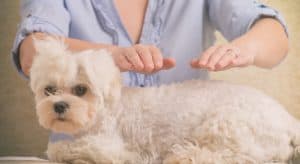Listed below are some Housebreaking Hints & Tips.
These tips may help with the following:
- A young puppy who is just learning about housebreaking
- A newly adopted dog who may have problems transitioning into your home or
- A dog in any stage of life who is having housebreaking issues for reasons such as age, illness, or behavior disorders.
1. Feed Your Dog At Set Times
Do not vary this schedule, even on the weekends. If your dog is eating his meals at set times, he will undoubtedly be pooping at approximate set times. The time window of a half-hour would be an acceptable definition of ‘set times’.
2. Take Your Dog Out On A Regular Schedule
Stay out with him and praise him when he eliminates and give him a treat. Do not begin praising the dog until he is completely finished eliminating. Praising too early may cause him to stop in the middle of ‘doing his business’ to receive his treat. A valuable lesson would not be learned.
3. Take The Dog Out To The Same Spot Each Time & Stand There
Do not talk. Be boring. Teach him that this spot or area is the place to relieve himself. And that is the only reason that you’re going out.
Take it a step further. Bring him in the house immediately after he eliminates. You may take him out five minutes later and play with him if you wish. But you want him to know that ‘doing his business ‘ was the only reason that you went outside.
If the dog views it as he went to play a bit and pee’d while he was out there, the lesson will not adhere as much as it could have if there were only a singular purpose for going outside.
Take the dog out after he eats or drinks after he wakes up ( even if it’s just a short nap). Take him out anytime he is let out of his crate, after he has played and if he starts to walk in a circular motion.
All of these events and behaviors are triggers for a dog to want to relieve himself. Especially a young puppy. Remember to take the dog out on a set schedule in addition to this.
Caught In The Act
If you catch the dog in the act of eliminating in the house you should say ‘No’ in an abrupt low pitched voice as you pick him up. Bring him directly outside to his special pee ‘spot’ or area and wait quietly.
Give him a few moments. He may continue to pee or he may not. In any case, praise him whether he ‘goes’ or not. He has learned from this that when he pees in the house you’re upset with him and rush him outside. You’re teaching him what the inappropriate behavior is redirecting him to the correct behavior.
Make A Housebreaking Log
Post it on your refrigerator in order that the entire family may record your dog’s behaviors on it. This log should include the following :
- The time you take your dog out to the bathroom,
- Whether or not he urinates or defecates at that time or does nothing,
- What time he eats, drinks, and naps.
- What time of day, if at all, he has an accident in the house.
- Note if it was urine or pooh and what room he had the accident in. Also, note if he was “caught in the act ” or not.
Under no circumstances should you take the dog to the place in the house where he had an accident and ‘rub his nose in it ‘ or yell at him.
If you do not ‘catch him in the act’, say nothing. Put him in a separate room until you clean up the mess.
Immediate Moment
Dogs associate your pleasure or displeasure with what they have done in that immediate moment. Therefore, if your dog pooped under the dining room table an hour earlier and you scold him for that once you discover it, he will not understand why you are scolding him.
He will associate your displeasure with what he happened to be doing right before you yelled at him. That could be chewing a bone or scratching himself, or anything!
Urinating In The Same Spot
If your dog smells urine in your house, he thinks that it’s okay to go in that spot again. That’s just how dogs are genetically programmed. If he continues to urinate you could try the following steps.
1. Treat Affected Area With Odor Neutralizer
This will chemically change the scent of the urine so it no longer smells like urine to the dog. Ideally, try and use an odor neutralizer that is also a stain remover. We reviewed a selection of dog pee carpet cleaners that would work in situations like this.
2. Never Use Ammonia Products
The reason is that urine also contains ammonia.
3. Invest in Pet Urine Detector
If you have a puppy or dog with chronic housebreaking issues, it would be good to invest in a pet urine detector. This will allow you to scan your rugs and fabric furniture etc to look for urine. You can then in turn treat these areas with an odor neutralizer.
Even the smallest few droplets of urine on the corner of a rug will be an invitation to a dog to urinate in that area. It’s just canine instinct. Ever notice when your dog goes for a walk, he likes to pee on top of other dogs’ pee! It’s the same theory.
At the very least, you should be abiding by all of these housebreaking hints. In and of themselves they should solve your problem or at the very least greatly reduce your dog’s housebreaking issues.
Some Other Factors To Consider
Vet Check
It is important to make sure your dog’s housebreaking issue isn’t for a medical reason. For example, he could have a Urinary Tract Infection, which is evidenced by frequent, small volumes or urine.
Other reasons could be:
- Geriatric incontinence
- Bladder infection or stones
- Kidney disease.
So take your dog to the veterinarian to eliminate a medical reason for your dog’s transgression. Bring a urine sample with you, as they will undoubtedly want to test for infection.
4 Behavioral Reasons for Housebreaking Problems
There are four Behavioral reasons why a dog might seemingly have housebreaking problems.
- Submission
- Excitement
- Marking
- History.
1. Submissive Urination
Some dogs can have what is called submissive urination, whereby they will tinkle when scolded or feeling submissive.
2. Excitable Urination
Other dogs have Excitable Urination.
In this case, their exuberance, when you come home from work for example, along with a full bladder can cause them to dribble. This behavior will usually correct itself over time if the pup is young. In some cases, it is a result of being spayed and can be a lifetime problem.
3. Marking
Marking is something that dominant dogs, usually male but occasionally female, will perform. They are marking territory to show that they were there. Some owners misconstrue this as urinating.
4. History
Finally, history can be a housebreaking issue for dogs who have been adopted. Not knowing a dog’s past can be difficult.
A dog you have adopted may have always had a problem throughout their lives with housebreaking accidents. In this case, you need to act as if they’re an eight-week-old puppy and housebreak them from scratch. These dogs are bright and can successfully learn to be completely housebroken.
Housebreaking Methods
This is another issue that can confuse a dog. You need to decide if you are going to paper train your dog or teach him to use the restroom outside from the beginning and use only that method.
1. Paper Train vs Outside
If you paper train him and then expect him to one day magically understand that he can no longer use the housebreaking pads you are in for an unpleasant surprise. You will essentially be training the dog twice.
Transitioning a dog from paper training to the outside is more difficult than just teaching them to go outside in the first place.
2. Crate Training
Crate training can be a very effective method when teaching your dog to develop his sphincter muscle to control his bladder.
Dogs do not like to eliminate where they sleep. So if the crate you are using is of the size that all your dog can do is walk in turn around and lie down, he will ‘hold it’. But be careful!
Some dogs will choose to urinate on the blanket in the crate and then nudge it with their nose to the back of the crate so that they don’t have to be near it. If your dog does this, he must sleep with no bedding.
If your dog is specifically having trouble holding it at night, it makes sense to pull the water bowl early! Pick a time for ‘last water”. That should be gauged by what time you go to bed. After that time if you feel your dog must have hydration, we suggest letting them lick on an ice cube.
Pay Attention To The Signs
Pay attention to your dog’s communication method relative to housebreaking. Sometimes our dogs tell us that they need to go out to the bathroom but we’re not noticing the signs.
- Your dog may bark inexplicably or scratch at the door.
- Another classic indicator would be your dog walking in a circle. Dogs typically do this in preparation to urinate. These are ‘signaling cues’.
Recognize them for what they are and help your dog help you housebreak him. If your dog does not give you a clue that he needs to relieve himself, you can teach him to ‘ ring a bell’. Check out Advice Center – Dear Labby for a description of this.
Proper Supervision During Housebreaking Process
Finally, a key element in gaining perfect housebreaking for your dog is proper supervision during the housebreaking process.
Dog House Training Guide
For a complete training guide to house train your dog, you should check out The Ultimate House Training Guide. It covers all the essential things you need to know on house training and covers canine behavioral issues and training techniques.









